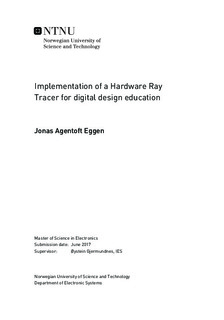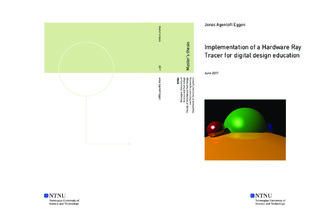| dc.description.abstract | Digital design is a large and complex field of electronic engineering, and learning digital design requires maturing over time. The learning process can be facilitated by making use of a single learning platform throughout a whole course.
A learning platform built around a hardware ray tracer can be used in illustrating many important aspects of digital design. A unified learning platform allows students to delve into intricate details of digital design while still seeing the bigger picture. Effects of changing parameters at a low level in the ray tracer design can be seen at the top-level straight away. This kind of fast feedback can help keep students motivated through the learning process.
Throughout this thesis, many interesting examples of both assignments and student discussions are presented. These cover topics such as technology dependent optimisations, low power design techniques, verification and means of accelerating the design process. The combination of these examples and the implementation effort in this thesis is a good starting point for a learning platform.
Ray tracing is a parallel problem well suited for processing in a multi-core architecture. Here, a system that can be synthesised with a parameterisable number of processing cores is proposed. Each of the cores interleave processing of rays using fine-grained multithreading. Large parts of the system have been implemented using the SystemVerilog hardware description language. Tools used in exploring the impact of architectural changes have been developed and results from these are discussed. The implementation is verified through simulations and partly using formal methods. Synthesis results for a Xilinx Zynq SoC are presented and discussed.
Simulation and synthesis results indicate that the ray tracer can render a VGA frame at 25 frames per second in a 32-core configuration. This configuration utilises ~ 77 % of the LUTs on the target FPGA, leaving room for additional logic on the device. | |

